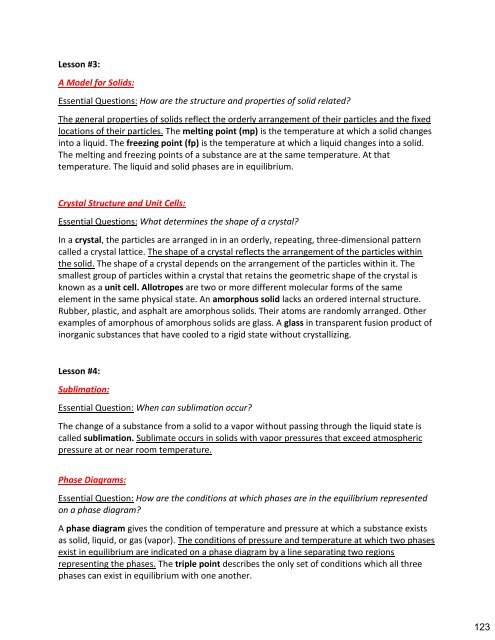Create successful ePaper yourself
Turn your PDF publications into a flip-book with our unique Google optimized e-Paper software.
Chapter 13: States of Matter<br />
Lesson #1:<br />
Learning Goal: Differentiate among the four states of matter/Relate temperature to the<br />
average molecular kinetic energy.<br />
Kinetic Theory and a Model for Gases:<br />
Essential Question #1: What are the three assumptions of the kinetic theory as it applies to<br />
gases?<br />
The energy an object has because of its motion is called kinetic energy. According to the kinetic<br />
theory, all matter consists of tiny particles that are in constant motion. The particles in gas are<br />
considered to be small, hard spheres with an insignificant volume. Particles are relatively far<br />
apart compared to the distance between particles in a liquid or solid within a gas. The motion<br />
of the particles in a gas is rapid, constant, and random. The third assumption of the kinetic<br />
theory as it applies to gases is that: All collisions between particles in a gas are perfectly elastic.<br />
Gas Pressure:<br />
Essential Question #2: How does kinetic theory explain gas pressure?<br />
Gas pressure results from the force exerted by a gas per unit surface are of an object. What<br />
causes this force is the force exerted by moving bodies when they collide with other bodies.<br />
Gas pressure is the result of billions of rapidly moving particles in a gas simultaneously colliding<br />
with an object. If no particles are present, then no collisions can occur, and there is no pressure.<br />
An empty space with no particles and no pressure is called a vacuum. The collisions of atoms<br />
and molecules in air with objects results in atmospheric pressure. A barometer is the device<br />
used to measure it (atmospheric pressure). The SI unit of pressure is the Pascal (Pa). Which<br />
represents a very small amount of pressure. One standard atmosphere (atm) is the pressure<br />
required to support 760mm of mercury in a mercury barometer at 25*C.<br />
Kinetic Energy and Temperature:<br />
Essential Question #3: What is the relationship between the temperature in kelvins and the<br />
average kinetic energy of particles?<br />
The kelvin temperature scale shows the relationship between temperature and average kinetic<br />
energy. The Kelvin temperature of a substance is directly proportional to the average kinetic<br />
energy of particles of the substance.<br />
121




